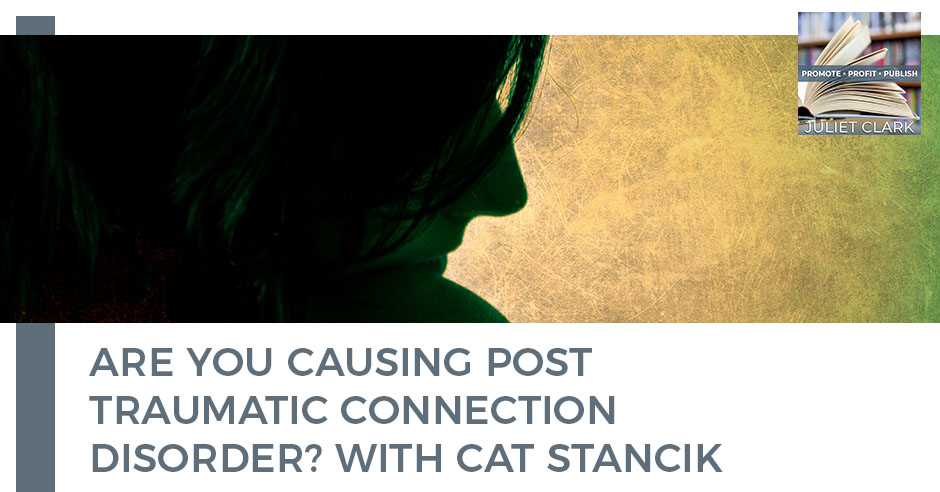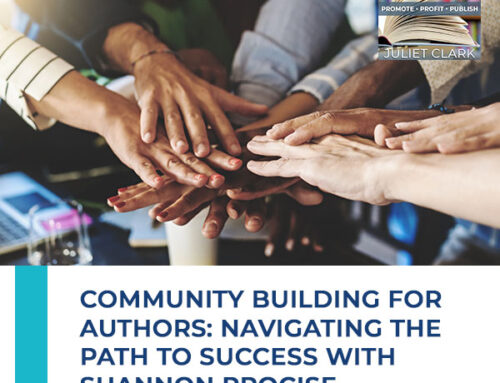
Did you know you could generate leads by not even being salesy at all? Stop causing post-traumatic connection disorder to people that you meet. Learn how to understand your ideal client so that they will come back to you and buy your product. Join your host Juliet Clark and her guest, the lead boss, Cat Stancik, on how to generate the right leads. Cat is the CEO of Action Incubator and the creator of the Lead Boss System. Learn how to invest in yourself and find qualified leads for your business. Really understand your client if you want to get the deal. Learn how to trust in your leads today!
—
Watch the episode here
Listen to the podcast here
Are You Causing Post Traumatic Connection Disorder? With Cat Stancik
We need to talk about lead generation. I’m super excited to have Cat Stancik on here to talk about that. Before we get started, I want to remind you to go over and take our Promote, Profit, Publish Quiz. You can find it at www.PromoteProfitPublishQuiz.com. Are you ready to publish? Do you have a platform? Who is going to buy your book? What are your next steps? Remember that book is not the end all be all. It is a marketing tool. Go over and find out if you are ready or if you have some work to do with audience building before that. If you’re somebody who likes visuals, we have a YouTube channel. Go over to Superbrand Publishing. Follow us over there.
We’re excited to have Cat. This conversation probably is going to go in some directions you don’t even understand. She is the person to go to for time-crunched entrepreneurs and CEOs and their teams, she’s known as The LEAD Boss, when they want to create more leverage in their business, and scale their revenues predictably with or without more demand on their time. Cat is the Founder of the Action Incubator, four times bestselling author, and the co-author of the international bestselling book Experts Never Chase. She is also the creator of the Lead Boss System. Welcome.
Thank you so much for having me. I appreciate you making the time.
We know a lot of people don’t spend October, November and December deciding, “Where am I going to get more leads? How am I going to generate more? How do I get the right or qualified leads?” You can get leads, but they can be crappy leads. Talk a little bit about what you do at Lead Boss and why do you think this is important.
That’s exactly why I do what I do, which is the things that you explained. When it comes to the emotions that are evoked when they think about generating leads, so many people tend to be negative. They tend to be something along the lines of, “I don’t want to do this. I don’t know how to do this. It’s wasting my time. I don’t want to waste more money. I tried this and that strategy.”
My focus is finding the strategy that you love so that you love doing lead generation, and flipping the switch on that relationship with lead generation because we know we can want to have sales calls, but if we don’t have any leads, we have no one to close. One of the things that I love saying is that you can have the worst sales call. I’ve had horrible sales calls. I’ve said all the wrong things. I didn’t follow the process but they still bought because they were the right lead.
You can have the worst sales call and still get the deal because you had the right lead.
That’s how we don’t waste our time. We want to make sure that we’re talking to the right people who are highly qualified, and that we’re qualifying people along our process so that we don’t waste their time and we don’t waste ours. This is about creating that match made in heaven and understanding that there is an abundance of people who want to work with you, but you’ve also got to know who they are. I don’t think enough people are spending enough time dialing in their ideal client.
They keep things at a superficial level but they don’t dive underneath the water and understand what are true qualifiers, how to get their attention, and how to make the conversation easier. Many people are okay with talking about the weather. We see it all the time online, but they don’t know how to go from talking about the weather to whether we should work together.
That weather to whether turn of the conversation is where most people get triggered by being salesy or sleazy. There are so many better ways than the bro-marketing, forced overcoming objections, manipulative NLP BS that’s out there where you can be in alignment with your strengths, and have a welcoming invitation that a lot of people say yes to.
When we both started, we did a lot of that bro-marketing. It didn’t feel good. One size fits all is not the answer. Once we both got in alignment, our businesses took off. Can you speak to that a little bit? We both had pretty bad experiences with that.
We’re talking about digital marketing. It’s not old. It’s still new when you come to look at industries that have been established. It’s newer than the car industry, manufacturing, and a lot of things, but it’s evolved very quickly. The initial strategy that used to be out there was to send an email and people would buy. That’s not the case anymore at all. It’s going to require more effort, and then came these manipulative strategies where the bros are like fungus or mold that grows in dark corners. They started spreading and causing all kinds of health issues. What happened in that space was they got to the frontline.

Post Traumatic Connection Disorder: So many people are okay with talking about the weather. But they don’t know how to go from talking about the weather to whether they should work together.
They provided strategies that did work, but they didn’t work in alignment with people who didn’t like showing up in that way. These are these hyper-aggressive, “I’m going to keep you on the phone and overcome all your objections until you finally give me your credit card.” They have strategies like, “I’m going to show you how you can increase your credit lines so you can buy my offer.” It’s these things that make you feel gross, and that feel gross when you do it to someone else. It is why people don’t like doing things on LinkedIn or social media because we’ve got all these people pitching you.
They are sliding into your DMs and giving you PTCD, Post-Traumatic Connection Disorder. Social media is already pretty negative. The algorithms are what sell. To have to deal with that, it becomes this place you don’t want to deal with, but there are a lot of good people and they just need to learn a different way. One that isn’t all about forcing a decision or making someone do something, but staying in that place of, “I’m going to add value to someone’s life and business,” whichever way you engage with someone with their business and all that and, “I’m going to be there when they’re ready to make a decision.”
It’s not this forced thing. It’s an open invitation. Part of that is looking at how you’re showing up and adding value. A lot of the strategies out there still work. The problem is that they’ve been perverted because they’re so hyper-focused on the pitch. We’ve seen it. We’ve gone to events where they try to pitch within the first ten minutes of you being there. They’re a pitch feast, pitch after pitch.
There is no real value. You walk away and you’re like, “I was here for three days but I didn’t do anything. I’m like, “What did I spend my time on? I know I did stuff.” I don’t like it. I don’t think that people have to do it to be successful. People who use those strategies are less successful. They’re putting a lot of space between them and their ability to create a business that supports their lifestyle.
My latest book is Pitchslapped. If you can generate those leads, get those people on a call, connect with them in a non-salesy way, and make the goal of the call relationship building, it’s much more successful. They may not buy that day, but they will keep in touch. They will come back.
That’s how you build a pipeline. There are so many people out there who want to hit the easy button. I get it. It’s tempting. It sells. It gets you in the moment of weakness. If you look at anything in your life, nothing came through an easy button approach. You had to learn things. You have to learn skillsets and then you were able to start delegating. You had to sit up before you could crawl, walk, run, ride a bike, get on an airplane and drive a car. There is a process to things.
You can actually generate leads by connecting with your customer in a non-salesy way.
There are ways to get results faster, but that doesn’t happen without you being actively involved. You can’t delegate effectively until you understand what it is you are delegating so that you can measure success. Many people want to skip to the front of the line. There are ways of doing that when you’re investing in yourself. Many people don’t want to invest and they don’t want to do the work. That’s going to keep you in an impoverished mindset and environment.
Especially when it comes to digital marketing, how many times do you hear people say when you lay out a strategy, “I don’t want to learn how to do that. I don’t have time.” That is where the biggest waste of marketing dollars comes in. If you don’t understand your marketing plan and the process they go through, how in the world are you going to know if it’s working or not?
I’ve seen digital marketing companies come back and do that, “It’s working,” but I don’t have any leads. They’re telling you it’s working but you’re not seeing the results. What happens a lot of times is the entrepreneur gets angry about it, but they’re not asking the marketer the right questions about the definition of “It’s working,” and why are you telling me that, and what can you show me?
It almost creates this horrible inverse relationship where people are so dependent. They’ve invested in these high ticket sales. That’s what I do and promote. That’s what I help my clients do. They’ve invested all this money. These people have convinced someone who’s probably not at the right level to invest all of these dollars. The problem is now their entire budget has been spent on investing in this person and they don’t have the resources to add to making that strategy work. They need that VA, OBM, copywriter, social media strategist and whatever it is to implement the strategy that this person is probably not even using anymore or that doesn’t even work. It wouldn’t work at the level that the person is at.
That’s why one size fits all doesn’t work because different people are at different stages. Different people have different strengths. Different people have different ideal clients. That’s why I like my process. I’m biased but it’s a framework that we modify to fit to your strengths. It’s all about, how do you show up in the world? How does your ideal client consume information? What’s the strategy that aligns them together, so you keep climbing that ladder of success?

Post Traumatic Connection Disorder: People learn differently. You should learn how to not force a decision or make someone do something.
Things like your quiz. Your quiz is such a great tool and strategy for a lot of people, but there are markets that don’t respond well to quizzes. You need to know that that’s not your ideal client. They don’t engage in that way. Yours is one of those strategies that are applicable, but the results matter. I’ve taken those quizzes where you’ve gotten the results and you’re like, “That was a waste of my time.”
I know you’re a proponent of delivering value as part of the results that people get. You look at the experience that you’re walking someone through. Your quizzes don’t take five hours to complete. You’re focused on the experience because so much of the experience that someone has with you dictate their willingness and desire to continue to have the conversation to work with you potentially.
As an entrepreneur, your reputation is built on your integrity with your clients, past clients, especially if you want referrals. One of the things that I would love to see more people be willing to do and that I do very well, it probably makes me a horrible business person, is if you come to me and you say, “I want a quiz where the outcome is there’s a wacky wizard of a social media superstar,” I’m not your girl. People are afraid to tell them, “There is no benefit in that. It doesn’t give you and them the information.” That’s one of the big things when you’re putting packages together for people.
If you go over to our website, we don’t have prices and packages. People say all the time, “I don’t know how much you cost.” I don’t know what you need. Everything is ala carte with us because we need to talk to you and find out what do you have built? What do you need? Where are you going with this? Can we help with that?
You’re calling out exactly something that’s important. There are different business models for different people and who they like to work with. That’s a business model. There are other business models where it might make sense to have a package because you’re walking people through a process. I have programs that are out there that are for groups. There’s a process I walk people through. I have programs out there that nobody knows about because they’re invitation-only. They’re high, high tickets because it depends on the person.
It’s a very qualified person because that’s the person I can get results for, and that’s the difference. I know exactly the person who will get results from this offer or this offer. I need to qualify them to see which one is in their best interest. Can I close someone at that higher ticket? Yeah, but that may not be what’s right for them. That’s why we want to make sure we understand our ideal clients because it’s not wrong to have multiple offers. It’s wrong to have the gazillion offers.
Value the relationship over the transaction.
We want to keep it simple, but it’s about understanding what lifestyle do you want to live? Not everybody wants to be a Fortune 100. I love working with boutique businesses. These are businesses that are them, but that doesn’t mean that they’re not earning multiple seven figures. It’s all possible but you have to make sure that you’re leveraging the right business model for your goals and how you want to live.
Let’s differentiate here. You’re out there generating leads. Are you wasting your time with unqualified leads? That’s where people spin their wheels. When I was in real estate, we had an office and we were one of the top producers in a very large company. People from the surrounding offices, other realtors would come and they’d go, “I have 67 leads.” We would look at them and go, “How many of them have contracts? How many of them are in the car?” A lead is not always a qualified lead. How do you differentiate and qualify?
People interchange these words all the time. There are prospects and there are leads. For me, a prospect is they’re very far away. You can see their outline but you’re not sure. Are they a guy or girl? They got blonde hair. They’re far in the distance. They look like a human blob but they’re not a lead yet. You don’t know their characteristics. You haven’t been able to qualify them. They’re not in focus. It’s someone with who you have that relationship. They know who you are and you know who they are. That’s where we start building the relationship.
It’s important to call out the fact that we value the relationship over the transaction. Many people look at a lead as a client or not a client. It’s like a yes/no situation. A lead is multi-dimensional. A lead is a potential client, but it’s also a referral partner, a JV or a friend. It’s also someone who can get you on a podcast or speaking gig. The list goes on in terms of the available options to you. Here’s where most people go wrong. They don’t keep walking through the doors. Once you pick one of those doors, all of those options become available to you again.
That’s how you turn one contact, one connection, one lead into an infinite supply of opportunity, but most people don’t keep track. They don’t follow up. They don’t fill their pipeline. They let connections and conversations fly by the wayside because they’re hunting for that next client instead of building a pipeline. Are you investing in the pipe dream or your pipeline? This one quick gimmick strategies, that’s all pipe dream stuff. It’s not putting food on the table. It’s not producing results.

Post Traumatic Connection Disorder: Not everybody wants to be a Fortune 100. You have to make sure that you’re leveraging the right business model for your goals and how you want to live.
A pipeline is something that will constantly provide you with all the options. Every time I fill my high ticket program, it’s not with a cold contact. Have I had cold contacts turned into clients? Absolutely. That’s not who I focus on. Every time I fill a group program, it’s someone I have contacts with. I’ve had a conversation. They see me speak. They’ve been in my world. They’re in my Facebook group. They’re on my email list. They are consuming until they’re ready to say yes. It’s my job to continue to provide them opportunities to say yes. It’s their job to put their flag in the air and say, “I’m ready.” You have to watch out because there’s the “I’m ready” flag, and then there’s the red flag.
A lot of times, people are like, “It’s an orange flag. It’s a yellow flag.” A flag is a flag. If a flag is orange or yellow, it’s been hanging out in the sun too long. If you see a flag on the play, you pass. We don’t work with unqualified people. That person is ready to work with someone else. You need to bless and release them, so they find the right resource so they get results.
Because you honor them, their values and yourself, who do you think they’re going to come back to when they are ready to work with you? Who do you think they’re going to refer? Their experience with you was a positive one. All of this is what you have to think about when building your pipeline and keeping track of those leads. We don’t want all the leads. We want to make sure we’re keeping track of the good leads.
That’s what we always tell people. A click is not a relationship. It might be the beginning of a relationship, but it is never the relationship. If you’re one of those people who are invested in clicks in a funnel and you’re like, “They got all the way,” but you haven’t talked to them.
Sell low ticket. Sell your $7 “tripwire,” which tripwire kills people. We don’t kill people with our copy. Look at the energy that you’re putting behind your strategies and what you’re naming things. You can do the $7 thing. There’s nothing wrong with that. I bought $7 and $17 courses. They’re still sitting in my inbox or my Google Drive somewhere. I never used them or I opened them up and said, “This is BS.” It’s the value, your experience and your authority. That’s why I go high ticket. When you know you can deliver a result and you know the people you can deliver results for, success is inevitable.
We had a situation a few years ago where somebody came up to the stage and they were like, “I want that program.” It was $25,000. I talked to him a little bit and he told me his skill level. I’m like, “You belong in our $500 program.” He so appreciated that he went through all of those programs step by step. He practically sold them to himself. He was grateful at the end. He’s referred a lot of people because we didn’t take his money and say, “You weren’t ready.” You do have to talk to people and listen.
Invest in your pipeline, not on your pipedream.
Let’s be clear and clarify something. Delivery does not end at the sales call. Many behave that way. “I got the money. I’m good.” You’re not. They’ve invested in you. You need to also invest in them. You’re investing with some kind of exchange, whether it’s time or strategy. Whatever you built, you better be delivering results consistently. You can only control what you can control. That’s why we qualify. That’s why guarantee works when you’ve got the right person. You want to make sure that you’re delivering beyond.
It’s like when you’re in the corporate world. When you do your job, you get paid to do your job. When you over-deliver, that’s when you get promoted. If you want your clients to work with you again, over-deliver. You’ll get promoted. They’ll buy from you again but you need to make sure that you’re supporting them in a way that makes them feel like they are empowered and not necessarily dependent on you. It is a beneficial relationship, not one where you’re using and abusing.
I used to have a program with our quiz set up where I taught people. At the end of the year, I would not take anybody on for a second year. It’s because, “You did it. It’s time for you to fly.” A lot of people would say that wasn’t a great model, but I thought it was because I don’t like that sales pitch at the end of the course so, “Let’s go into your next one now.” I’m ready to go on to something different.
I can so respect that because there is a timeframe. We’re only here to play in someone else’s life for a certain timeframe. We’ve got to be completely present in our lives, but we’re only a stepping stone for someone. Wherever they decide to go, that’s fine. There is a time and place, and sometimes that stepping stones are bigger, sometimes they are smaller. We need to know what that space is. There are ways of making money off of that same person. That sounds a little aggressive but if you have your community and you know exactly who they need to work with next to continue to get the results, you can refer them and you’re still monetizing that relationship.
What’s going to happen is exactly what happened to you, which is they’re going to become your ambassadors because you were in integrity, and you treated them like human beings. Treating someone like they’ve got a pulse and that they can make decisions in their business. It’s putting strategic effort into creating ease in your business. There are lots of these opportunities but people always want to pass by them, and they end up turning in circles and creating more work for themselves.

Post Traumatic Connection Disorder: When you do your job, you get paid to do your job. When you over-deliver, you get promoted. So if you want your clients to work with you again, over-deliver. They’ll buy from you again.
I want to share something with you guys that I like to do a lot. If I have clients, prospects or even past clients and I happen to be giving a talk or in an event in their city, I always invite them to lunch. No sales pitch. It’s just, “It’s great to meet you in person. Let’s talk.” That’s where I get most of my referrals. It’s the people who are like, “Really? You want to meet me?” It’s not a big deal to meet me but it’s more of like, “Nobody else I’ve worked with wanted to do that.”
That’s what I call keeping on someone’s radar. This is a great example of what you’re doing. I come from a corporate background. I used to be a high-level consultant, managing hundreds of people on a team and hundreds of millions of dollars on projects and things like that. There was always someone knocking on my door and be like, “I need this. I need that.” There’s a constant barrage of interruption. If we think about our engagement online, that’s what’s happening. Someone is constantly interrupting and bothering you in the middle of your day, pinging you in your email, getting you on direct message, and distracting you from what you’ve been trying to do.
Let’s change the scenario a little bit. Someone knocks on your door and says, “I’ve got ping tickets. Do you want to come? I’m going out to lunch. Do you want to come?” You want to come because it’s going to be an enjoyable experience. It’s something you enjoy and value. Interrupt somebody with value. Don’t interrupt someone to take. Most people are out to take. Whether you’re asking them to join your Facebook group, do this thing or do that thing, you are taking from them instead of giving in the first place.
We are so used to being asked for something that when someone gives us somethig, we welcome it with open arms. When you build the relationship by giving value without the attachment to something, that person is going to see you in a different light because you’re not behaving like everybody else out there. They completely forgot their manners. They’re not human beings and they’re acting like complete jerks online. Part of what you’re doing when you’re doing the event and inviting people out is you’re creating that context, good value, pleasant emotions and feelings. You’re tying them to that.
When you realize this, it will change how you do business. Your clients typically buy when they are in crisis. If you understand that, you can show up in a loving and caring way without taking advantage of their low point. I call them firework experiences. What is it that you’re doing that gives so much value that they’re inviting people to join them? They’re going and planning it in their day. They’re going to sit there in awe and a-ha because you are amazing, and you’re driving so much value for them.
They’re going to want to see what that next step is. It may not be right after that, but I’ve had many a time where I’ve done one of these experiences. I’ve invited people to a call or this other next step and someone hasn’t booked something. I ran into them in person and they say, “I’ve been meaning to book a call with you and I keep forgetting.” It’s why we keep making the invitation because, at some point, they are going to be ready to buy. If you don’t invite consistently and figure out what the right question is to ask, they can’t say yes.
Delivery does not end at the sales call.
Cat, this has been amazing. I hope you guys got a lot of value out of this. How can we find you? What are the next steps if somebody wants to get ahold of you?
I have something called the Lead Boss Jump Start. I’ve pulled out pieces of my Lead Boss System. This is stuff that I teach people. It’s a three-part training. You get instant access. The first part is all about structuring your hourly agenda day because that’s how you should be managing your time at the end of the day. You should be able to maintain your process an hour a day. The second piece is you are already connected to $100,000 without adding a single new person to your connection list and cold people onto your pipeline. These are social media swipes that are going to help some of those people pop their hands up to say, “I’m ready to work with you.”
The third piece is my close script. My clients and I use it to help close 80% to 90% of our sales calls. Those three things are immediately available to you. They are downloadable. Here’s my caveat. This is my languaging. This is my personality. Change it to match yours. These are templates. Don’t copy and paste. Infuse your personality, brand and persona so that people relate to you and want to buy it from you. You can find that at FullyBooked.ceo.
I love that you cover all of those aspects because we’ve had people with our quiz. They are out there. They are using it. They are getting leads and they are not good closers. It’s a big thing to be a good close on there. Thank you so much. This has been amazing.
Thank you so much for having me. I super appreciate it.
Important Links
- www.PromoteProfitPublishQuiz.com
- Superbrand Publishing – YouTube
- Action Incubator
- Experts Never Chase
- Pitchslapped
- FullyBooked.ceo
About Cat Stancik
 Time crunched Entrepreneurs and CEOs (and their teams) call Cat, known as the LEAD Boss, when they want to create more leverage in business, to scale revenues predictably, without more demand on their time. Cat, is the founder of Action Incubator, four times best selling author, and co-author of international bestselling book “Experts Never Chase” and creator of the Lead Boss System.
Time crunched Entrepreneurs and CEOs (and their teams) call Cat, known as the LEAD Boss, when they want to create more leverage in business, to scale revenues predictably, without more demand on their time. Cat, is the founder of Action Incubator, four times best selling author, and co-author of international bestselling book “Experts Never Chase” and creator of the Lead Boss System.
Love the show? Subscribe, rate, review, and share!









Leave A Comment